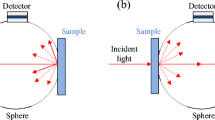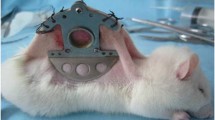Abstract
The design criteria and feasibility of specifically targeting blood vessels for thermal damage by using a pulsed alexandrite infra-red laser to heat an intravascularly injected infra-redabsorbing dye, namely indocyanine green (ICG), is demonstrated. Theoretical calculations map the distribution of light and heat in and around the subcutaneous blood vessels in a rat skin-flap window chamber as functions of dye concentration, vessel size, and vessel depth. Theoretical calculations showed that an injected dose of 6–24 mgkg−1 of ICG and a 120-μs, 1-J cm−2 alexandrite laser pulse at a wavelength of 785 nm would be sufficient to achieve selective vascular damage to a depth of at least 0.15 cm. Feasibility experiments were performed which illustrated that an irradiation of 1.27 J cm−2 of skin flaps in uninjected control rats showed no evidence of vascular damage while vascular damage was seen in skin flaps using an experimental protocol of 12 mg kg−1 i.v. of ICG and an energy fluence of 0.76 J cm−2. This procedure could conceivably prove useful in the treatment of vascular lesions or cancer.
Similar content being viewed by others
References
McKenzie AL. Physics of thermal processes in laser-tissue interaction.Phys Med Biol 1990,35:1175–209.
Boulnois JL. Photophysical processes in recent medical laser developments: a review.Lasers Med Sci 1986,1:47–66
Anderson, RR, Parrish JA. Microvasculature can be selectively damaged using a dye laser: a basic theory and experimental evidence in human skin.Lasers Surg Med 1981,1:263–76
Anderson RR, Jaenicke KF, Parrish JA. Mechanisms of selective vascular changes caused by dye lasers.Lasers Surg Med 1983,3:211–5
Tan OT, Sherwood K, Gilchrist BW. Treatment of children with port-wine stains using the flashlamp-pulsed tunable dye laser.new Eng J Med 1989,320:416–21
Lund-Johansen P. The dye dilution method for measurement of cardiac output.Eur Heart J 1990,11 (Suppl 1):6–12
Fox IJ. Indocyanine green: physical and physiologic properties.Staff Meet Mayo Clinic 1960,35:732–44
Destro M, Puliafito CA. Indocyanine green videoangiography of choroidal neovascularization.Ophthalmology 1989,96:846–53
Libutti SK, Oz MC, Forde KA et al. Canine colonic anastamoses reinforced with dye-enhanced fibrinogen and a diode laser.Surg Endos 1990,4:97–9
Oz MC, Johnson JP, Parangi S et al. Tissue soldering by use of indocyanine green dye-enhanced fibrinogen with the near infrared diode laser.J Vasc Surg 1990,11:718–25
DeCoste SD, Farinelli W, Flotte T, Anderson RR. Dye enhanced laser welding for skin closure.Lasers Surg Med 1992,12:25–32
Anderson RR, Puliafito CA, Gradoudas, ES, Steinert RF. Dye enhanced laser photocoagulation of choroidal vessels (abstract).Invest Opthal Vis Sci 1985,26:89
Oseroff A, Kirschmann R, Anderson RR, Parrish JA, Dye-enhancement and pulse-width dependence of selective laser-induced thermal injury to cutaneous vessels (abstract).J Invest Derm 1984,82:435
Brooks SG, Ashley S, Fisher J et al. Exogenous chromophores for the argon and Nd:YAG lasers: a potential application to laser-tissue interactions.Lasers Surg Med 1992,12:294–302
DeCoste SD, Farinelli W, Flotte T, Anderson RR. Dye-enhanced laser welding for skin closure.Lasers Surg Med 1992,12:25–32
Papenfuss HD, Gross JF, Intaglietta M, Treese FA. A transparent access chamber for the rat dorsal skin fold.Microvasc Res 1979,18:311–8
Stern SJ, Flock ST, Small S et al. An implantable tumor-window chamber model for the study of photodynamic therapy.Otolaryn Head Neck Surg 1991,105:556–66
Turro NJ.Modern Molecular Photochemistry. California: Benjamin/Cummings, 1978
Dorr, MB, Pollack GM. Specific assay for the quantitation of indocyanine green in rat plasma using high-performance liquid chromatography with fluorescence detection.J. Pharm. Sci. 1989,78:328–33
McEvoy G (ed).AHFS Drug Information 1990. American Society of Hospital Pharmacy (Md), 1990:1311–2
van Gemert MJC, Welch AJ. Time constants in thermal laser medicine.Lasers Surg Med 1989,9:405–21
Walsh JT, Flotte TF, Anderson RR, Deutsch TF. Pulsed CO2 laser tissue ablation: effect of tissue type and pulse duration on thermal damage.Lasers Surg Med 1988,8:108–18
Birngruber RF, Hillenkamp F, Gabel VP. Theoretical investigations of laser thermal retinal injury.Health Physics 1985,48:781–96
Dewhirst MW, Tso CY, Oliver R et al. Morphologic and hemodynamic comparison of tumor and healing normal tissue microvasculature.Int J Rad Onc Biol Phys 1989,17:91–9
Jacques SL, Prahl, S. Modelling optical and thermal distributions in tissues during laser irradiation.lasers Surg Med 1987,6:494–503
Atkins PWPhysical Chemistry, San Francisco: W.H. Freeman, 1978
Welch AJ, Pearce JA, Diller KR. Rate process modeling of laser induced tissue damage (preprint 1993)
Welch AJ. The thermal response of laser irradiated tissue.IEEE J Quant Elec 1984.QE-20:1471–81
Pickering JW, Butler PH, Ring BJ, Walker EP. Computed temperature distributions around ectatic capillaries exposed to yellow (578) laser light.Phys Med Biol 1989,34:1247–58
Paul BS, Anderson RR, Jarve J, Parrish JA. The effect of temperature and other factors on selective microvascular damage caused by a pulsed dye laser.J Invest Derm 1983,81:333–6
Flock ST, Wilson BC, Patterson MS, Wyman DR. Monte Carlo modeling of light propagation in highly scattering tissues. I. model predictions and comparison with diffusion theory.IEEE Trans Biomed Eng. 1989,36:1162–8
Keijzer M, Jacques SL, Prahl, SA, Welch AJ. Light distributions in artery tissue: Monte Carlo simulations for finite-diameter laser beams.Lasers Surg Med 1989,9:148–54
Cheong WF, Prahl SA, Welch AJ. A review of the optical properties of biological tissues.IEEE J Quant Elec 1990,26:2166–85
Saidi IS, Jacques SL, Tittel FK. Optical properties of neonatal skin.Proceedings of the Conference on Lasers Electro Opt (CLEO), Anaheim, CA 1990.
Flock ST, Wilson BC, Patterson MS. Total attenuation coefficients and scattering phase functions of tissues and phantom materials at 633 nanometers.Med Phys 1987,14:835–41
Author information
Authors and Affiliations
Rights and permissions
About this article
Cite this article
Flock, S.T., Jacques, S.L. Thermal damage of blood vessels in a rat skin-flap window chamber using indocyanine green and a pulsed alexandrite laser: A feasibility study. Laser Med Sci 8, 185–196 (1993). https://doi.org/10.1007/BF02547875
Received:
Issue Date:
DOI: https://doi.org/10.1007/BF02547875




